2008 Photo Gallery
The photographs presented here represent a selection of species from The IUCN Red List of Threatened Species (2008) and were contributed from a range of sources including IUCN SSC Specialist Group members. These photographs may be freely used for any non-commercial purpose, but please credit the respective photographers. For commercial use, please contact the photographers directly. For a wider selection of threatened species imagery, please see ARKive
(www.arkive.org), an online multi-media of the world's species.
Mammals
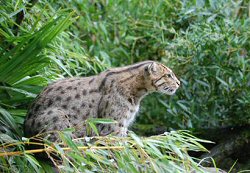
|
The Fishing Cat (
Prionailurus viverrinus
) has changed category from Vulnerable to Endangered because of the severe decline throughout much of its Asian range over the last decade. It is a medium sized cat and a skilful swimmer, found mainly in wetland habitats such as swamps, oxbow lakes, reed beds, tidal creeks and mangrove areas. Over 45 per cent of protected wetlands in Southeast Asia are considered threatened, including those that are home to this species. Sites like the estuaries of the Karnataka coast (Southwestern India), and the deltas of the Irrawaddy, Indus, Mekong and Red rivers. Threats to the Fishing Cat include human settlement, draining of its habitat for agriculture, pollution, excessive hunting, wood-cutting and over-fishing. In addition, clearance of coastal mangroves over the past decade has been rapid. The depletion of fish stocks from over-fishing is likely to be a significant threat to this species which relies heavily on fish for its survival. Photo ©
Mathieu Ourioux.
|

|
The Caspian Seal (
Pusa caspica
) has moved from Vulnerable to Endangered. It occurs throughout the Caspian Sea, using the winter ice sheets as a surface on which to give birth and nurse pups. Its population has declined by 90 percent over the last 100 years due to unsustainable levels of commercial hunting, habitat degradation and pollution; it is still decreasing. Since 2005 the number of pups born has plummeted by a catastrophic 60 percent to just 6,000-7,000. A low survival rate among pups has led researchers to fear there are barely enough breeding females to keep the population viable. Photo ©
Simon Goodman
(University of Leeds/Caspian International Seal Survey).
|

|
The Black-footed Ferret (
Mustela nigripes
) from North America is no longer Extinct in the Wild after a massive effort to reintroduce captive animals back to parts of its range. The species is highly dependent on prairie dogs as its food-source; the widespread extermination of prairie dogs throughout the 20th century, and the spread of disease, caused massive declines in the Black-footed Ferret population. In 1985, the species was on the verge of extinction when its last free-ranging population collapsed from an outbreak of canine distemper. Once widespread in central North America, it now exists only in reintroduced populations and is currently listed as Endangered. From 1991 to 2008, a captive breeding programme by the United States Fish and Wildlife Service brought the Black-footed Ferret back to Mexico and eight western states in the US. At present, it is considered self-sustaining at only three locations; two in South Dakota and one in Wyoming. Photo ©
Dean E. Biggins.
|

|
The African Elephant (
Loxodonta africana
) occurs in some 37 countries in sub-Saharan Africa, and are found in dense forest, open and closed savannah, grassland and, at considerably lower densities, even in the arid deserts of Namibia and Mali. Poaching for ivory and meat has traditionally been the major threat to the species. Across the continent, the total population is believed to have suffered a decline of approximately 25% between 1979 and 2007, which falls short of the 30% threshold required for a Vulnerable listing. As such, the African Elephant has been down-listed from the Vulnerable category to Near Threatened. It is believed that the change in status reflects recent and ongoing population increases in major populations in Southern and Eastern Africa, largely due to the implementation of highly successful conservation efforts, and which have been of sufficient magnitude to outweigh any decreases that may be taking place elsewhere across their vast range. Photo © IUCN Photo Library /
Alicia Wirz.
|

|
The Grey-Faced Sengi (
Rhynchocyon udzungwensis
) is a newly discovered species of elephant-shrew from Tanzania. The species is listed as Vulnerable because it is known from only two areas, which are prone to fires caused by drought and by humans from the expanding settlements nearby. It belongs to a group of mammals called Afrotheria that evolved in Africa over 100 million years ago and whose relatives include elephants, sea cows, and the Aardvark. Elephant-shrews get their name because of their long, flexible snouts rather than their genetic relatives. The Grey-faced Sengi was only described in 2008 after being caught on film in 2005 in the remote Ndundulu Forest in Tanzania's Udzungwa Mountains. It is the first new species of giant elephant-shrew to be discovered in more than 126 years and is over 25 per cent larger than any other known sengi. A rapid loss of habitat could quickly push this species into a higher threat category. Although it is found within protected areas, increased human population pressure around the forest edges could have a negative effect on this species. The predicted effects of global climate change will likely further reduce its already fragmented habitat. Photo ©
F. Rovero
(Trento Museum of Natural Sciences, Italy).
|

|
The Fergusson Island Striped Possum (
Dactylopsila tatei
) is found on only one of the D'Entrecasteaux Islands (Fergusson Island), Papua New Guinea. The species is not well known, but it is thought to be restricted to primary tropical moist forest areas between 600 and 1,000 m altitude. Its presumed restricted range and reliance on a habitat that is under threat from expanding agriculture has resulted in this possum being assessed as Endangered. More research is needed to gather data to further refine the status of this species. Photo ©
Pavel German.
|

|
Grevy's Zebra (
Equus grevyi
) is confined to the Horn of Africa, specifically Ethiopia and Kenya. This Endangered zebra has undergone one of the most substantial range reductions of any African mammal. It is estimated to have declined by more than 50% over the past 18 years, and the current population has approximately 750 adult animals. The main reasons for the decline of this species are reduction of available water sources (for example, in the Ewaso Ng'iro River over-abstraction of water for irrigation schemes has reduced dry season river flow by 90% over the past three decades); habitat degradation due to overgrazing by domestic livestock, which are also out-competing Grevy's Zebra for access to food; hunting; and disease (for example, an outbreak of anthrax in the Wamba area of southern Samburu, Kenya resulted in the death of more than 50 animals). Photo ©
Jean-Christophe Vié.
|

|
The Asiatic Wild Ass (
Equus hemionus
) moved from Vulnerable to Endangered in 2008 because it is estimated to have declined by more than 50% over the past 16 years, and it continuing to decline. In historic times, this species was widespread across Asia, from China in the East, to Turkey in the West. By the 19th century, their range had declined significantly, and today the most abundant population occurs in the southern part of Mongolia and adjacent northern China, with smaller, isolated, wild and reintroduced populations scattered around its former range. One subspecies, the Syrian Wild Ass (E. h. hemippus) is now Extinct. A suite of human-caused threats have resulted in the decline of this species, including habitat loss as human settlements and agriculture expand, competition with livestock for food and habitat, and poaching. The species is now susceptible to outbreaks of disease and drought which can quickly cause catastrophic declines in the remaining small and isolated populations. Photo ©
Jean-Christophe Vié.
|
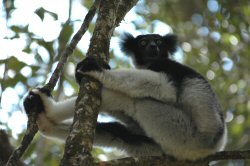
|
The Indri (
Indri indri
) is an Endangered primate from Madagascar. It is threatened by the ongoing loss of rainforest habitat to supply fuel and timber and to make way for slash-and-burn agriculture. Hunting of the Indri was considered taboo by many local people (and still is in some areas), but such beliefs are breaking down in many regions and hunting pressure (for skins, which were worn as clothing, and meat) is now quite significant in some areas. It is estimated that the population has declined by more than 50% over the last 36 years. Photo ©
Jean-Christophe Vié.
|
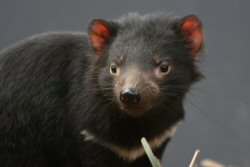
|
The Tasmanian Devil (
Sarcophilus harrisii
) is now a threatened species, moving from Least Concern to Endangered. The size of a small dog and found only on the Australian island state of Tasmania, the devil is the largest carnivorous marsupial in the world. The global population of this species has declined by more than 60 percent over the last 10 years due to a fatal infectious cancer. Devil Facial Tumour Disease (DFTD), is spread amongst Tasmanian Devils through biting and from sharing the same food. Once infected, the animal develops tumours around the mouth, which interferes with feeding and eventually leads to death by starvation. Photo ©
David Hewett.
|
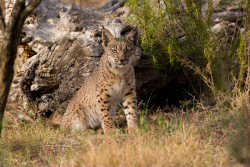
|
The Iberian Lynx (
Lynx pardinus
) has a total population of only 84–143 adults, restricted to areas of Spain and Portugal, qualifying the species as Critically Endangered. The continued decline in the Lynx's population is due in part to the severe depletion of its primary prey, the European Rabbit (Oryctolagus cuniculus). The introduction of Myxomatosis to control rabbits in the 1950s decimated the lynx's main food source and caused the population to crash. When rabbit recovery seemed possible, viral haemorrhagic pneumonia then struck. In an attempt to maintain Iberian Lynx numbers, conservationists have bred and released rabbits, while the wild population has developed a natural immunity to Myxomatosis. Additional threats to the Iberian Lynx include injuries from snares set for rabbits and accidental deaths from speeding vehicles on the expanding road network. Disease and illegal shooting also threaten the population. The lynx is confined to scattered groups in the southwestern Iberian peninsula where its habitat has been severely fragmented by infrastructure improvement, urban and resort development as well as pine and Eucalyptus plantations. Photo ©
Antonio Rivas.
|

|
Pere David's Deer (
Elaphurus davidianus
) is Extinct in the Wild. Known in Chinese as Milu, their English name is derived from the French missionary Father Armand David. The last wild population is thought to have been eaten by troops during the Boxer Revolution at the turn of the 19th century. They were reintroduced into China in the late 1980s from captive animals bred in Europe; these reintroduced animals have been managed since then and are not considered as wild. The captive population in China has increased in recent years, and the possibility remains that free-ranging populations can be established sometime in the near future. At that point, its IUCN Red List status will need to be reassessed. Photo © Jessie Cohen, courtesy of
National Zoological Park.
|
Birds

|
The Mallee Emuwren (
Stipiturus mallee
) is an Endangered Australian species that is undergoing a very rapid population decline. Clearance of its habitat for agriculture and livestock grazing has resulted in its current fragmented range, but the greatest threat to this bird is large-scale wildfires. The population is estimated to be around 10,000 individuals, with less than 2,000 km2 of suitable habitat left. Immediate sensitive habitat management is needed to help slow the worrying declines of this species. Photo ©
Tony Crittenden.
|

|
Kirtland's Warbler (
Dendroica kirtlandii
) is a species that currently is showing improvement in its Red List status. This species has very specific breeding habitat requirements, which restricts its breeding range to a small area in Michigan's Lower Peninsula, United States. Between 1961 and 1971, counts of singing male warblers declined by over 50%, and this prompted a suite of conservation measures to be put in place to stabilize the population. This included controlling the population of Brown-headed Cowbird (Molothrus ater), which predates on young warblers, population monitoring, and active management of the breeding habitat. As a result of these conservation measures, the breeding population of Kirtland's Warbler more than tripled between 1990 and 2000. Previously listed as Vulnerable on the Red List, this species was downlisted to Near Threatened in 2004. Population numbers have continued to increase since then, but as its population and breeding range are still small, it remains in the Near Threatened category in 2008. Photo ©
J. Wunderle.
|

|
The Slender-billed Vulture (
Gyps tenuirostris
) was once a common species, but in Southeast Asia it declined through the latter half of the 19th century and the first half of the 20th century; it is now listed as Critically Endangered. A recent survey recorded small numbers in Myanmar; very sharp declines have been noted in the last few years in India and Nepal; it is now thought to be extinct in Thailand and Malaysia, and the only recent Southeast Asian records are from Cambodia and southern Laos. By mid-2000, Gyps vultures were being found dead and dying in Nepal and India, and major declines and local extirpations were reported. There is strong evidence that Gyps vultures are fatally susceptible to veterinary painkillers containing Diclofenac. East of India, the near-total disappearance of the species pre-dated the present crisis, and probably results from the rarity there of large wild mammals and human consumption of deceased livestock. Photo ©
Dave Dick.
|
Reptiles

|
The Cuban Crocodile (
Crocodylus rhombifer
) is a freshwater crocodile renowned for its leaping ability, which allows it to prey on forest dwelling mammals. Relatively small in size, it is also thought to be one of the more intelligent crocodiles. It has changed status from Endangered to Critically Endangered because of population declines caused by illicit hunting. Its meat is used in restaurants and its skin for clothing. Hybridization with the American Crocodile (Crocodylus acutus), is a newly recognised major threat to the Cuban Crocodile, decreasing its genetic purity and already limited range. Photo ©
J. Thorbjarnarson
/ WCS.
|
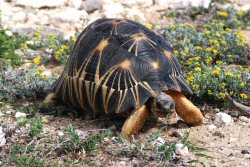
|
The Radiated Tortoise (
Astrochelys radiata
) is endemic to Madagascar and in 2008 its Red List status moved from Vulnerable to Critically Endangered. Historically this species has been quite abundant, often being found along roadways and has served as symbol of Madagascar's south. However, this is no longer the case; its range has contracted by one fifth over the last 25 years and the population is declining. Wild Radiated Tortoises are collected for the international pet trade, and also for local use (food and pets), which is of greater concern for the species; in 2003 it was estimated that up to 45,000 adult Radiated Tortoises are harvested each year and harvest levels may have increased since then. Habitat loss due to agricultural expansion and invasive plant species also threaten the remaining wild population. Photo ©
Anders Rhodin.
|
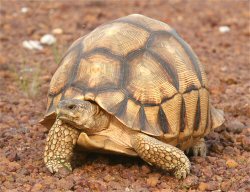
|
Astrochelys yniphora
The Ploughshare Tortoise (Astrochelys yniphora) was uplisted from Endangered to Critically Endangered in 2008. This species has a very small range, occurring only around Baly Bay in northwestern Madagascar. The total wild population is estimated at about 600 individuals and is declining. Its current restricted range and past declines are believed to be the result of exploitation (poaching for the international pet trade) and habitat loss caused by deliberate fires. It is near certain that the species will become extinct within the next generation (42 years) if the current level of threats continue unabated. Photo ©
Anders Rhodin.
|
Amphibians

|
Holdridge's Toad (
Incilius holdridgei
) is a rainforest amphibian species from Costa Rica that was declared Extinct in 2008. In spite of regular and extensive surveys, most recently in 2007, the species has not been seen since 1986. It is thought that this species may be one of the more recent victims of chitridiomycosis, a fungal disease which has caused widespread declines in amphibians around the world. Photo ©
Wayne Van Devender.
|

|
The Black-eared Mantella (
Mantella milotympanum
) occurs in several fragmented localities in east-central Madagascar covering a small area south of Fierenana. This area is severely threatened, with forest habitat receding due to the impacts of subsistence agriculture (including livestock grazing), timber extraction, charcoal production, the spread of eucalyptus, fires, and expanding human settlements. This Critically Endangered amphibian has, in the past, been collected in large numbers by commercial collectors, and trade might pose a major threat to the species. Photo ©
Franco Andreone.
|
Fishes

|
The Squaretail Coral Grouper (
Plectropomus areolatus
) is a medium-sized grouper found on the coral reefs of the Indo-Pacific. It is listed as Vulnerable because of its importance in the luxury live reef food fish trade (LRFFT). This grouper is taken in massive numbers from its spawning aggregations where adults come together to spawn for short periods each year. The fish are then kept alive during shipment to Hong Kong, the global trade centre for live marine fish. The huge market for LRFFT amongst wealthy consumers in China and in Chinese communities around the world means that demand for this trade almost certainly exceeds the natural capacity of groupers. The Squaretail Coral Grouper cannot be farmed therefore all fish are caught from the wild. As a result of this increasingly heavy fishing pressure at spawning aggregations, many have now disappeared from some countries. Photo © .
John E. Randall.
|

|
The Black Grouper (
Epinephelus mystacinus
) is one of the many Least Concern species included on the IUCN Red List. Its deep-water habitat in the Western Atlantic and apparently constant catch rates suggest that the species is not suffering serious declines at present. However, it is targeted both by recreational and target fisheries, and little is known about this grouper's biology, therefore further research and ongoing population monitoring are important activities to ensure any significant declines or serious threats are detected and measures are put in place in time to prevent the species moving out of the Least Concern category. Photo ©
Craig Dahlgren.
|
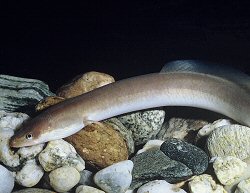
|
The European Eel (
Anguilla anguilla
) has suffered serious population declines and in 2008 it was declared a Critically Endangered species. Since the early 1980s, there has been a decline of 90% in the recruitment of juvenile eels, and in 2001 recruitment was only 1-2% of the pre-1980 level. All available information indicates that the European Eel stock is at an historical low in most of its range and it continues to decline. The causes of the declining recruitment rates are still unclear, some of suggestions include overfishing; the introduced parasitic nematode Anguillicola crassus, which may impact the ability of eels to reach their spawning grounds; dam construction for hydropower and water management, which block migration routes and cause high mortality rates as downstream migrating eels are killed by turbines; possibly climate change affecting the breeding grounds in the Sargasso Sea, and increasing numbers of predators (e.g. cormorants). Photo ©
Janez Gregori.
|

|
Cottus petiti
is a Vulnerable freshwater fish, restricted to a 3 km stretch of the Lez River in France. Water pollution and drying out of the river are major threats to this fish. Future introduction of Cottus gobio into the river is a serious potential threat to this species. Photo ©
Jörg Freyhof.
|
Invertebrates

|
The Rameshwaram Parachute Spider (
Poecilotheria hanumavilasumica
) is a species of Indian tarantula assessed for the first time in 2008 and listed as Critically Endangered. Found only on the island of Rameshwaram and nearby mainland, the spider occurs in an area less than 100 km2, of which perhaps 6 km2 are occupied by this species. The Rameshwaram Parachute Spider lives in palm, casuarina and tamarind plantations, as well as mixed deciduous woodland and sometimes in thatch-roof houses. The total population of this spider is likely to number less than 500 adults. Its natural habitat has almost completely been destroyed due to the development of plantations for other uses, a major threat to this species. Increased tourism in the last few years has resulted in the conversion of two plantations to tourist developments where at least 70 Ramwshwaram Parachute Spiders had previously been observed. All the spiders were killed by loggers while the sites were being razed. Although it is not found extensively in the international pet trade, a few specimens have been taken out of the country, further reducing this precarious population. Photo ©
M. Siliwal.
|

|
The Peacock Parachute Tarantula (
Poecilotheria metallica)
is a very rare, Critically Endangered spider known from a single location in the Eastern Ghats of Andhra Pradesh, India. Habitat loss and degradation, caused by logging for firewood and timber materials, are major threats to this restricted-range species. There have also been incidents of this species being smuggled out of India and advertised for the pet trade in Europe; for such a rare species, this could be a serious threat. Photo ©
Sanjay Molur..
|

|
The Purple Marsh Crab (
Afrithelphusa monodosa
) from upper Guinea, West Africa was almost completely unknown to science until recently. Despite a single specimen discovered in 1947, the first living crabs were only collected in 2005 from a small group living in holes in waterlogged farmland. These unusual, long-legged crabs are semi-terrestrial air-breathers, foraging by night and hiding in the shallow water that collects in their burrows during the day. This is one of the five freshwater crab species found only in this region, and their continued survival depends on the protection of their wetland habitat. Listed as Endangered the Purple Marsh Crab is increasingly under threat from rainforest being converted for agriculture. The fact that this species is not found in a protected area casts doubt on its long-term survival without conservation action. Photo ©
Neil Cumberlidge..
|

|
The Tree Hole Crab (
Globonautes macropus
) was originally known from a single specimen collected in Liberia in 1898, and was not collected again for 90 years until it was rediscovered in 1988. It is endemic to the Upper Guinea rainforests of Liberia and Guinea, and may also occur in the forested parts of Sierra Leone which lie between these two countries. Before 1989, the population was estimated to be about 5-10 crabs per km2 of closed canopy rainforest, but this may well be declining as deforestation progresses. This Endangered crab appears to rely on rainwater-filled natural holes in suitably-sized trees at a height of 1-2 m above the ground. Loss and degradation of rainforest habitat is ongoing due to the increasing human population, deforestation, regional wars, and political instability. Photo ©
Neil Cumberlidge..
|
Plants

|
The Western Prairie Fringed Orchid (
Platanthera praeclara
) is a rare, North American orchid, which is particularly threatened by habitat destruction and degradation. Large tracts of prairie habitat have been lost due to conversion of land for agricultural production, and conversion for housing and commercial uses. This plant was assessed as Endangered in 2008 based on recorded population declines over the previous ten years. Photo ©
Jim Fowler.
|
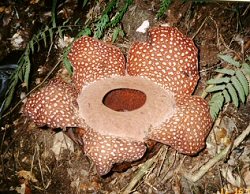
|
Rafflesia magnifica
is among the group of plants that produce the largest single flowers in the world. Endemic to the Philippines, only a few individuals of R. magnifica have been recorded, all of them male. The species is listed as Critically Endangered because of its very small population size and restricted range. Construction of a national highway in the area has facilitated easier human access and disturbance poses a threat to this rare plant as its unusual flowers are often treated as visitor attractions. Parts of the forest are also being converted into banana plantations. Photo ©
H. Calalo.
|





























